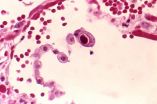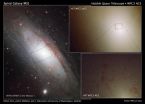(Press-News.org) A new clinical Standard Reference Material (SRM) from the National Institute of Standards and Technology (NIST) will help health care professionals more accurately diagnose and treat cytomegalovirus (CMV), a common pathogen that is particularly dangerous for infants and persons with weakened immune systems.
CMV is found in 50 to 80 percent of the population. It is a member of the herpes family of viruses that includes two herpes simplex viruses (the causes of cold sores and genital herpes), the varicella-zoster virus (the cause of chicken pox and shingles) and the Epstein-Barr virus (the cause of mononucleosis). Like its cousin herpes viruses, CMV generally remains latent in an infected person unless certain conditions trigger its activation. CMV poses a significant health risk to people who are immunocompromised (such as organ transplant patients or cancer patients undergoing chemotherapy) and babies who receive the virus from their mothers before birth. Congenital CMV infections cause more long-term problems and childhood deaths than many other prenatal disorders including fetal alcohol syndrome, Down syndrome and neural tube defects such as spinal bifida.
If a CMV infection becomes dangerous, antiviral agents can be used to moderate the impact. Unfortunately, many of these compounds are toxic, so a physician must know the severity of the infection—a measure known as viral load (number of virus copies per microliter of blood)—to prescribe the optimal dosage and duration of treatment. The current means of measuring viral load is to use polymerase chain reaction (PCR)—the standard technique for "amplifying" or making multiple copies of a DNA segment or molecule—to amplify a region of the CMV gene and then use a calibration curve to estimate the number of virus particles in the original sample. Accuracy of these measurements can vary greatly from one test facility to another as there are many different PCR protocols used to determine viral load, including commercial and "in-house" (privately developed) laboratory assays.
The new NIST reference, SRM 2366, addresses the variability problem by providing a standardized CMV DNA. Consistency of the viral DNA in the standard was ensured by manufacturing it in Escherichia coli bacteria. These E. coli cells each contain a copy of the CMV genome in a "DNA construct"—an artificially constructed segment of nucleic acid that codes for a specific product, in this case, CMV DNA. The DNA copies made by this E. coli cell culture "factory" can then be purified and quantified using digital PCR
SRM 2366 consists of three solutions, each with a specific concentration of CMV DNA copies per microliter: 420, 1,702 and 19,641. These are designed to qualify prepared calibration samples (known as calibrants). They also can be used as quality control samples for diagnostic equipment. For added traceability, the SRM certificate of analysis includes the genetic sequences of the nine CMV genome regions copied for the standard.
SRM 2366 joins more than 50 reference materials produced by NIST for quality control in clinical testing. Standard Reference Materials are among the most widely distributed and used products from NIST. The agency prepares, analyzes and distributes about 1,300 different materials that are used throughout the world to check the accuracy of instruments, validate test procedures and serve as the basis for quality control standards worldwide.
INFORMATION:
To get information on purchasing SRM 2366 and download the certificate of analysis, go to https://www-s.nist.gov/srmors/view_detail.cfm?srm=2366.
NIST standard available for better diagnosis, treatment of cytomegalovirus
2012-01-13
ELSE PRESS RELEASES FROM THIS DATE:
Stretching exercises: Using digital images to understand bridge failures
2012-01-13
With a random-looking spatter of paint specks, a pair of cameras and a whole lot of computer processing, engineer Mark Iadicola of the National Institute of Standards and Technology (NIST) has been helping the Federal Highway Administration (FHWA), in cooperation with the American Association of State Highway and Transportation Officials (AASHTO), to assure the safety of hundreds of truss bridges across the United States. Iadicola has been testing the use of a thoroughly modern version of an old technique—photographic measurement or "photogrammetry"—to watch the failure ...
NIST releases 2 new SRMs for monitoring human exposure to environmental toxins
2012-01-13
The National Institute of Standards and Technology (NIST), in collaboration with the Centers for Disease Control and Prevention (CDC), has developed two new Standard Reference Materials (SRMs) for measurements of human exposure to environmental toxins. Used as a sort of chemical ruler to check the accuracy of tests and analytic procedures, the new reference materials replace and improve older versions, adding measures for emerging environmental contaminants such as perchlorate, a chemical that the Environmental Protection Agency has targeted for regulation as a contaminant ...
Outlook for an industry that touches 96 percent of all manufactured goods
2012-01-13
The chemical industry, which touches 96 percent of all manufactured goods, is seeing some positive signs for 2012, although the overall outlook is not very rosy. Growing demand for chemicals used in agriculture, electronics, cars and airplanes will boost an industry that generates $674 billion in sales in the U.S. alone, but expiring patents and global economic woes will take a toll. These forecasts and others are in the cover story in the current issue of Chemical & Engineering News (C&EN), the weekly newsmagazine of the American Chemical Society, the world's largest scientific ...
'I feel your pain ...'
2012-01-13
Imagine the following scenarios: a co-worker is spoken to condescendingly, excluded from a meeting, or ignored by a supervisor. How does it make you feel? Do you feel differently depending on whether your co-worker is a man or a woman? According to a new study, workers who witness incivility towards colleagues feel negative emotions – especially when the incivility is aimed at workers of the same sex. The work, by Kathi Miner from Texas A&M University and Angela Eischeid from Buena Vista University, Iowa, is the first to look at the relationship between employees' observations ...
ALMA early science result reveals starving galaxies
2012-01-13
Astronomers using the partially completed ALMA observatory have found compelling evidence for how star-forming galaxies evolve into 'red and dead' elliptical galaxies, catching a large group of galaxies right in the middle of this change.
For years, astronomers have been developing a picture of galaxy evolution in which mergers between spiral galaxies could explain why nearby large elliptical galaxies have so few young stars. The theoretical picture is chaotic and violent: The merging galaxies knock gas and dust into clumps of rapid star formation, called starbursts, ...
OU researchers predict the next big thing in particle physics: Supersymmetry
2012-01-13
A better understanding of the universe will be the outgrowth of the discovery of the Higgs boson, according to a team of University of Oklahoma researchers. The team predicts the discovery will lead to supersymmetry or SUSY—an extension of the standard model of particle physics. SUSY predicts new matter states or super partners for each matter particle already accounted for in the standard model. SUSY theory provides an important new step to a better understanding of the universe we live in.
Howard Baer, Homer L. Dodge Professor of High Energy Physics in the OU Department ...
NASA sees Tropical Storm Heidi approaching Australia's Pilbara coast
2012-01-13
Tropical Storm Heidi is forecast to make landfall today along the Pilbara coast of Western Australia as warnings pepper the coast. NASA's Aqua satellite passed overhead early in the day and captured a visible image showing Heidi's center still north of the Pilbara coast, while her outer bands continue to bring rainfall and gusty winds to coastal residents.
NASA's Aqua satellite passed over Heidi on January 11, 2012 at 02:30 UTC (Jan. 10 at 10:30 a.m. EST) and the Moderate Resolution Imaging Spectroradiometer captured a visible image of the storm. The image showed that ...
Rare ultra-blue stars found in neighboring galaxy's hub
2012-01-13
Peering deep inside the hub of the neighboring Andromeda galaxy, NASA's Hubble Space Telescope has uncovered a large, rare population of hot, bright stars.
Blue is typically an indicator of hot, young stars. In this case, however, the stellar oddities are aging, sun-like stars that have prematurely cast off their outer layers of material, exposing their extremely blue-hot cores.
Astronomers were surprised when they spotted these stars because physical models show that only an unusual type of old star can be as hot and as bright in ultraviolet light.
While Hubble has ...
Hubble zooms in on double nucleus in Andromeda galaxy
2012-01-13
A new Hubble Space Telescope image centers on the 100-million-solar-mass black hole at the hub of the neighboring spiral galaxy M31, or the Andromeda galaxy, the only galaxy outside the Milky Way visible to the naked eye and the only other giant galaxy in the local group.
This is the sharpest visible-light image ever made of the nucleus of an external galaxy.
The event horizon, the closest region around the black hole where light can still escape, is too small to be seen, but it lies near the middle of a compact cluster of blue stars at the center of the image. The ...
People mimic each other, but we aren't chameleons
2012-01-13
It's easy to pick up on the movements that other people make—scratching your head, crossing your legs. But a new study published in Psychological Science, a journal of the Association for Psychological Science, finds that people only feel the urge to mimic each other when they have the same goal.
It's common for people to pick up on each other's movements. "This is the notion that when you're having a conversation with somebody and you don't care where your hands are, and the other person scratches their head, you scratch your head," says Sasha Ondobaka of the Donders ...



